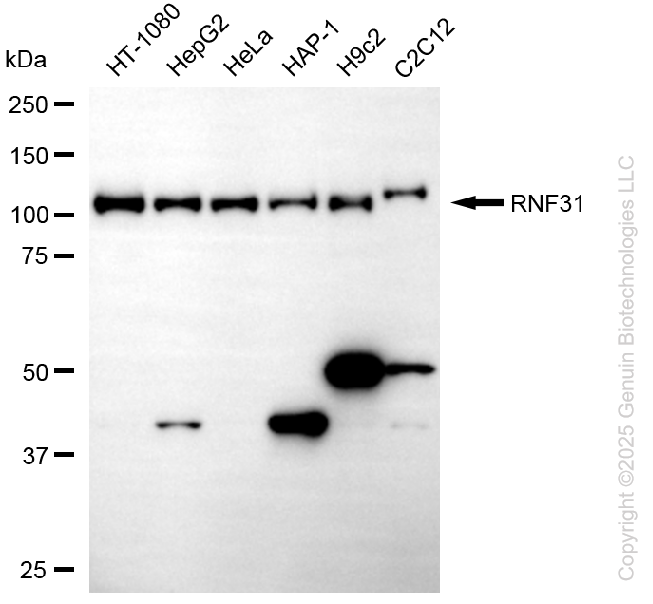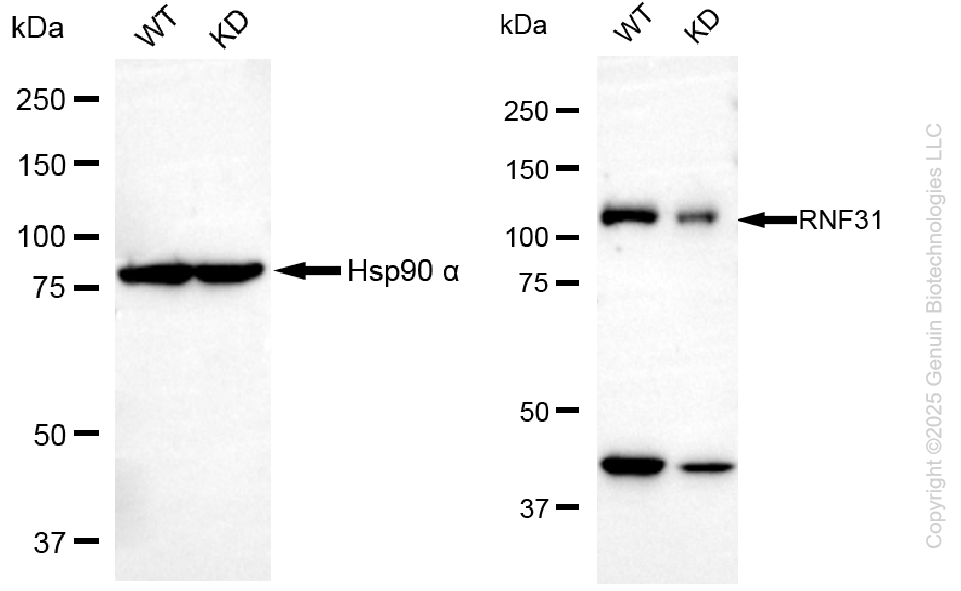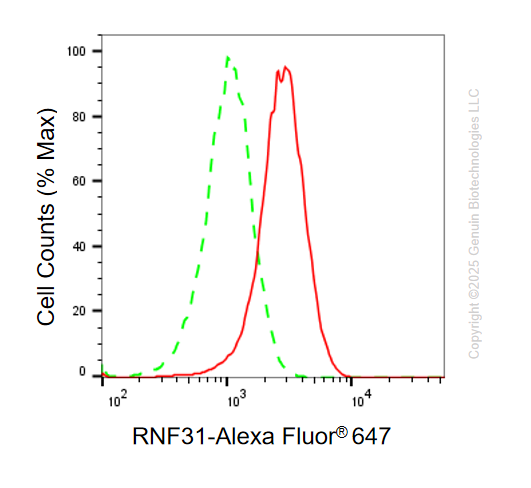KD-Validated Anti-RNF31 Mouse Oligoclonal Antibody
Mouse oligoclonal antibody
- SPECIFICATION
- CITATIONS
- PROTOCOLS
- BACKGROUND

Application
| WB, FC, ICC |
|---|---|
| Primary Accession | Q96EP0 |
| Reactivity | Rat, Human, Mouse |
| Clonality | Oligoclonal |
| Isotype | Mouse IgG |
| Calculated MW | Predicted, 120 kDa, observed, 120 kDa |
| Gene Name | RNF31 |
| Aliases | RNF31; Ring Finger Protein 31; ZIBRA; HOIP; HOIL-1-Interacting Protein; Paul; Zinc In-Between-RING-Finger Ubiquitin-Associated Domain Protein; RING-Type E3 Ubiquitin Transferase RNF31; E3 Ubiquitin-Protein Ligase RNF31; FLJ1011; FLJ23501; RING Finger Protein 31; EC 2.3.2.31; IMD115 |
| Immunogen | Recombinant protein of human RNF31 |
| Gene ID | 55072 |
|---|---|
| Other Names | E3 ubiquitin-protein ligase RNF31, 2.3.2.31, HOIL-1-interacting protein, HOIP, RING finger protein 31 {ECO:0000312|HGNC:HGNC:16031}, RING-type E3 ubiquitin transferase RNF31, Zinc in-between-RING-finger ubiquitin-associated domain protein, RNF31 (HGNC:16031) |
| Name | RNF31 (HGNC:16031) |
|---|---|
| Function | E3 ubiquitin-protein ligase component of the LUBAC complex which conjugates linear ('Met-1'-linked) polyubiquitin chains to substrates and plays a key role in NF-kappa-B activation and regulation of inflammation (PubMed:17006537, PubMed:19136968, PubMed:20005846, PubMed:21455173, PubMed:21455180, PubMed:21455181, PubMed:22863777, PubMed:28189684, PubMed:28481331). LUBAC conjugates linear polyubiquitin to IKBKG and RIPK1 and is involved in activation of the canonical NF-kappa-B and the JNK signaling pathways (PubMed:17006537, PubMed:19136968, PubMed:20005846, PubMed:21455173, PubMed:21455180, PubMed:21455181, PubMed:22863777, PubMed:28189684). Linear ubiquitination mediated by the LUBAC complex interferes with TNF- induced cell death and thereby prevents inflammation (PubMed:21455173, PubMed:28189684). LUBAC is recruited to the TNF-R1 signaling complex (TNF-RSC) following polyubiquitination of TNF-RSC components by BIRC2 and/or BIRC3 and to conjugate linear polyubiquitin to IKBKG and possibly other components contributing to the stability of the complex (PubMed:20005846, PubMed:27458237). The LUBAC complex is also involved in innate immunity by conjugating linear polyubiquitin chains at the surface of bacteria invading the cytosol to form the ubiquitin coat surrounding bacteria (PubMed:28481331, PubMed:34012115). LUBAC is not able to initiate formation of the bacterial ubiquitin coat, and can only promote formation of linear polyubiquitins on pre-existing ubiquitin (PubMed:28481331). Recruited to the surface of bacteria by RNF213, which initiates the bacterial ubiquitin coat (PubMed:34012115). The bacterial ubiquitin coat acts as an 'eat-me' signal for xenophagy and promotes NF-kappa-B activation (PubMed:28481331, PubMed:34012115). Together with OTULIN, the LUBAC complex regulates the canonical Wnt signaling during angiogenesis (PubMed:23708998). RNF31 is required for linear ubiquitination of BCL10, thereby promoting TCR-induced NF-kappa- B activation (PubMed:27777308). Binds polyubiquitin of different linkage types (PubMed:23708998). |
| Cellular Location | Cytoplasm {ECO:0000250|UniProtKB:Q924T7}. |
| Tissue Location | Expressed in both normal and transformed breast epithelial cell lines. |

Thousands of laboratories across the world have published research that depended on the performance of antibodies from Abcepta to advance their research. Check out links to articles that cite our products in major peer-reviewed journals, organized by research category.
info@abcepta.com, and receive a free "I Love Antibodies" mug.
Provided below are standard protocols that you may find useful for product applications.
If you have used an Abcepta product and would like to share how it has performed, please click on the "Submit Review" button and provide the requested information. Our staff will examine and post your review and contact you if needed.
If you have any additional inquiries please email technical services at tech@abcepta.com.














 Foundational characteristics of cancer include proliferation, angiogenesis, migration, evasion of apoptosis, and cellular immortality. Find key markers for these cellular processes and antibodies to detect them.
Foundational characteristics of cancer include proliferation, angiogenesis, migration, evasion of apoptosis, and cellular immortality. Find key markers for these cellular processes and antibodies to detect them. The SUMOplot™ Analysis Program predicts and scores sumoylation sites in your protein. SUMOylation is a post-translational modification involved in various cellular processes, such as nuclear-cytosolic transport, transcriptional regulation, apoptosis, protein stability, response to stress, and progression through the cell cycle.
The SUMOplot™ Analysis Program predicts and scores sumoylation sites in your protein. SUMOylation is a post-translational modification involved in various cellular processes, such as nuclear-cytosolic transport, transcriptional regulation, apoptosis, protein stability, response to stress, and progression through the cell cycle. The Autophagy Receptor Motif Plotter predicts and scores autophagy receptor binding sites in your protein. Identifying proteins connected to this pathway is critical to understanding the role of autophagy in physiological as well as pathological processes such as development, differentiation, neurodegenerative diseases, stress, infection, and cancer.
The Autophagy Receptor Motif Plotter predicts and scores autophagy receptor binding sites in your protein. Identifying proteins connected to this pathway is critical to understanding the role of autophagy in physiological as well as pathological processes such as development, differentiation, neurodegenerative diseases, stress, infection, and cancer.





